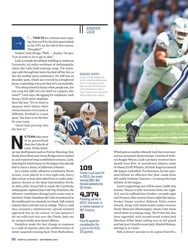
The Case for ... Independence
WHAT THE HELL is going on here? Simona Halep thought to herself. The world's second-ranked player, Halep faced Danielle Rose Collins, a junior at Virginia who won the NCAA singles title in May, during the first round of the U.S. Open last week. The two had never played before; in fact, Halep, a 22-year-old Romanian, had barely heard of Collins. With little to lose other than a few days of fall semester classes, Collins swung away and won the first set 7--6.
Halep inventoried the situation and then undertook an exercise in problem-solving. She forced the action in the second set, hitting with depth but to the middle of the court, robbing Collins of angles. She played more shots to Collins's backhand, which she discerned to be her weaker side. Barely an hour later Halep walked off the court a winner, 6--7, 6--1, 6--2. Without the benefit of metrics or teammates or a coach offering advice, she took control of the match with her ability to assess her opponent and adjust.
The locker room bromide tells us that sports build character. But especially at the pro level, sports also reveal character. How do these athletes handle moments of crisis? How well do they know themselves? How do they—if at all—overcome hubris or self-pity, adverse calls from the officials, jeering fans and so many other factors that can undermine success?
All of this is thrown into vivid relief in individual sports. In the debate over whether Kevin Love is a bane or a boon to the Cavaliers' chemistry or whether Eli Manning has a capable corps of receivers, the implication is that the unit matters most. In individual sports, it's a unit of one. The athlete is exposed, with no fig leafs to conceal imperfections. This is competition, DIY-style.
And tennis might be the ultimate individual sport. There are no pelotons to ward off challengers, no caddies to help with club selection, no cornermen dispensing Vaseline and encouragement in equal measure between rounds. A telling moment from last week: With Michael Jordan watching from the stands, Roger Federer—decorated athlete, unrivaled champion, man with a nine-figure net worth—walked onto the court schlepping his own equipment. The symbolism was unmistakable: It's on you. As Andre Agassi once famously put it, "Tennis is the closest thing to solitary confinement."
Regardless, the WTA has tried to undercut this virtue with a stunningly tone-deaf gimmick: Since 2009 women have been permitted to consult with coaches during changeovers or an opponent's requested break. (Fortunately, the policy is not in effect at Grand Slam events.) The visuals are terrible, damsels in distress relying on others—invariably, older males who make up the majority of WTA coaches—for assistance. And the players are among the policy's most vocal critics. We got this, they say, inherently grasping the core beauty of individual sports. "Honestly," says 19-year-old Madison Keys, who lost in the second round, "if they got rid of on-court coaching, I wouldn't be sitting in a corner crying and not know how to play tennis anymore." Federer recently was more direct: "You can look over to your coach for comfort and support, but other than that, I think tennis should be one of those unique sports where you don't get coaching."
There are, of course, great virtues to team sports: the beauty and symphony of the collective. There are practical benefits too. When players on teams are injured, the games still go on. When Rafael Nadal gets hurt—he couldn't defend his Open title because of a balky right wrist—his fans are out of luck.
When the U.S. Open singles winners hoist their trophies next week, they don't have to worry about passing them around. They did it. They get the glory. Every match is a self-referendum. Every match is an opportunity to be a tiger, a cavalier, a giant.
Without the benefit of a coach, Halep took control of the match with her ability to assess her opponent and adjust.
PHOTO
JUSTIN LANE/EPA

